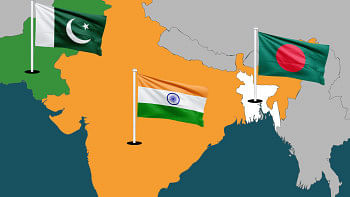Battle for higher GDP growth to dominate monetary policy
The central bank will face two daunting challenges -- maintaining a healthy GDP growth and containing inflation -- in its new monetary policy to be announced tomorrow for the second half of the current fiscal year.
In the face of severe political violence throughout the first half, the government has already decided to revise down the growth target to 6.3 percent. In this backdrop, economists said Bangladesh Bank will have to take a cautious stance and focus more on growth rather than inflation.
The government at the beginning of the current fiscal year had set the economic growth target at 7.2 percent though the central bank and development partners projected the rate to be between 5.5 percent and 6 percent due to political turmoil and low investment.
Bangladesh's economy suffered a loss of Tk 49,000 crore or 4.7 percent of gross domestic product (GDP) due to political turmoil in the last six months, according to estimates by Centre for Policy Dialogue.
The central bank in its monetary policy announced in July last year projected that the private sector credit growth would be 15.5 percent by the yearend. But the growth till November last year was 11.13 percent, down from 11.04 percent in June.
On the other hand, inflation has been rising gradually in recent months. The rate went up 0.02 percentage point in December, on an average, over the previous month and stood at 7.53 percent.
CPD's Executive Director Mustafizur Rahman said the next monetary policy should lay more emphasis on growth rather than stability as the fundamentals of the economy are more or less stable.
He said, though there was slight inflationary pressure on the economy it would not be wise to adopt a contractionary policy. He said there is nothing to worry if import in the balance of payments (BoP) increases slightly to stimulate growth.
He also said the central bank may lower some policy rates which will create pressure on the banks to cut lending rates.
Rahman, however, said the central bank should remain alert so that the local currency does not appreciate further.
The stimulus packages for the garment sector should be designed in such a way that benefits both small and big factories equally, he said.
While allowing the private sector to borrow from foreign sources, the BB should look into the maturity period and interest rate on the loan so that the foreign exchange reserves do not feel extensive pressure during repayment, the CPD executive director said.
Zahid Hussain, lead economist at World Bank's Dhaka office, said the near term outlook is lower growth and somewhat higher inflation due to supply side disruptions caused by prolonged political agitation and violence.
A cautious monetary policy stance is warranted under this outlook. Reserve and broad money growth will have to remain restrai-ned and in line with projected nominal GDP growth rate, Hussain said.
He said exchange rate may come under depreciation pressure when earnings from exports begin to slow and if remittance decline experienced in the first half is not reversed, he said.
Foreign exchange market intervention should be used to ensure orderly depreciation if such pressure arises. Greater exchange rate flexibility than allowed of late is warranted. Sterilisation should be used to avoid excessive monetary tightening if reserve buffers are used to smooth exchange rate volatility, Hussain said.
Revenue growth of the National Board of Revenue has slowed to around 14.5 percent through November. Excess liquidity in banks provides room for financing the cash flow shortages the government may be facing as a result of the growing revenue shortfall, notwithstanding the shortfall in ADP expenditures as well.

 For all latest news, follow The Daily Star's Google News channel.
For all latest news, follow The Daily Star's Google News channel. 



Comments